Spanien |
|
|
|
| Übersicht – Contents: | |
Spanien |
|
|
|
| Übersicht – Contents: | |
Flaggen – Flags: |
|
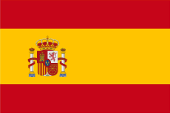 |
National-, Staats- und Marineflagge – national, state and naval flag, Seitenverhältnis – ratio = 2:3, Quelle/Source, nach/by: Flags of the World, Corel Draw 4  |
 |
Handelsflagge – merchant flag, Seitenverhältnis – ratio = 2:3, Quelle/Source, nach/by: Flags of the World, Corel Draw 4   |
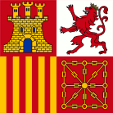 |
Gösch – naval jack, Seitenverhältnis – ratio = 1:1, Quelle/Source, nach/by: Flags of the World, Corel Draw 4 |
 |
seit/since 1981, Nationalflagge für private Hochseejachten – national flag for private high-sea yachts, Seitenverhältnis – ratio = 2:3, Quelle/Source, nach/by: Flags of the World, Corel Draw 4 |
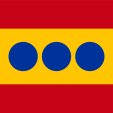 |
Flagge für Admirale – flag for admirals, Seitenverhältnis – ratio = 1:1, Quelle/Source, nach/by: Flags of the World |
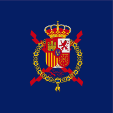 |
seit/since 1975, Standarte des Spanischen Königs – standard of the Spanish king, Seitenverhältnis – ratio = 1:1, Quelle/Source, nach/by: Wikipedia (ES) |
historische Flaggen – historical Flags: |
|
 |
1230–1479, Flagge von Kastilien-León – flag of Castile-León, Quelle/Source, nach/by: Flags of the World   |
 |
ca.1479–ca.1701, Flaggen – flags, Varianten von vielen – variants out of many, Quelle/Source, nach/by: Flags of the World, histor. Pix/Abbildungen |
 |
ca. 1516–ca.1790, Marine- und Kriegsflagge und Flagge der Außenbesitzungen – Naval and war flag and flag in the colonies, Quelle/Source, nach/by: Flags of the World, histor. Pix/Abbildungen  |
 |
1668–1700, Wappenbanner des Königs – banner of the King's Arms, Quelle/Source, nach/by: Wikipedia (ES) |
 |
1700–1761, Wappenbanner des Königs – banner of the King's Arms, Quelle/Source, nach/by: Wikipedia (ES) |
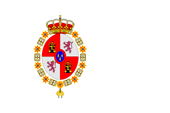 |
1701–1748, Flagge unter den Bourbonen – flag under the Bourbons, (vereinfachte Variante – simplifyed variant), Quelle/Source, nach/by: World Statesmen, histor. Pix/Abbildungen |
 |
1759–1808, Flagge unter den Bourbonen – flag under the Bourbons, (vereinfachte Variante – simplifyed variant), Quelle/Source, nach/by: World Statesmen, histor. Pix/Abbildungen |
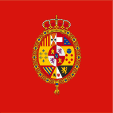 |
1761–1834, Standarte des Spanischen Königs – standard of the Spanish king, Seitenverhältnis – ratio = 1:1, Quelle/Source, nach/by: Wikipedia (ES) |
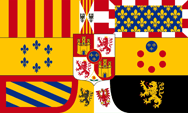 |
1761–1868, Wappenbanner des Königs – banner of the King's Arms, Quelle/Source, nach/by: Wikipedia (ES) |
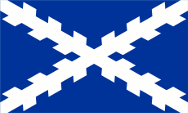 |
bis/to 1762, Handelsflagge – merchant flag, Quelle/Source, nach/by: Flags of the World |
 |
1785–1931, Staats- und Marineflagge – state and naval flag, Seitenverhältnis – ratio = 2:3, Quelle/Source, nach/by: Flags of the World |
 |
1873–1874, Staats- und Marineflagge – state and naval flag, Seitenverhältnis – ratio = 2:3, Quelle/Source, nach/by: Flags of the World |
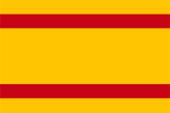 |
1785–1927, National- und Handelsflagge – national and merchant flag, Seitenverhältnis – ratio = 2:3, Quelle/Source, nach/by: Flags of the World |
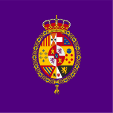 |
1838–1868, 1875–1931, Standarte des Spanischen Königs – standard of the Spanish king, Seitenverhältnis – ratio = 1:1, Quelle/Source, nach/by: Wikipedia (ES) |
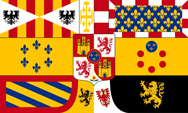 |
1886–1931, Wappenbanner des Königs – banner of the King's Arms, Quelle/Source, nach/by: Amazon |
 |
1927–1931, National- und Handelsflagge – national and merchant flag, Seitenverhältnis – ratio = 2:3, Quelle/Source, nach/by: Flags of the World   |
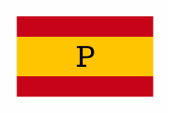 |
1928–1931, Lotsen(ruf)flagge – Pilot jack, Seitenverhältnis – ratio = 2:3, Quelle/Source, nach/by: Flags of the World, FOTW Diese Art Flaggen wurde im 20. Jahrhundert abgeschafft, heute gilt – This type of flag was abolished in the 20th century, today is: |
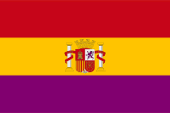 |
1931–1936, Staats- und Marineflagge – state and naval flag, Seitenverhältnis – ratio = 2:3, Quelle/Source, nach/by: Flags of the World  |
 |
1931–1936, National- und Handelsflagge – national and merchant flag, Seitenverhältnis – ratio = 2:3, Quelle/Source, nach/by: Flags of the World  |
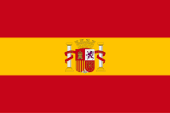 |
1936–1938, Staats- und Marineflagge – state and naval flag, Seitenverhältnis – ratio = 2:3, Quelle/Source, nach/by: Flags of the World  |
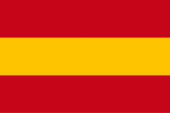 |
1936–1938, National- und Handelsflagge – national and merchant flag, Seitenverhältnis – ratio = 2:3, Quelle/Source, nach/by: Flags of the World |
 |
1936–1938, Flagge der aufständischen karlistischen Truppen – flag of the revolting Carlist troops, Seitenverhältnis – ratio = 2:3, Quelle/Source, nach/by: Wikipedia (DE)  |
 |
1940–1975, Standarte des Caudillo Franco Bahamonde – standard of the Caudillo Franco Bahamonde, Seitenverhältnis – ratio = 1:1, Quelle/Source, nach/by: Flags of the World  |
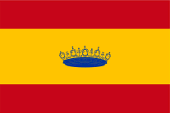 |
1938–1981, Nationalflagge für private Hochseejachten – national flag for private high-sea yachts, Seitenverhältnis – ratio = 2:3, Quelle/Source, nach/by: Flaggenbuch 1939 |
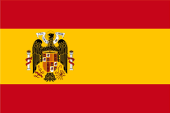 |
1938–1945, Staats- und Marineflagge – state and naval flag, Seitenverhältnis – ratio = 2:3, Quelle/Source, nach/by: Flags of the World  |
 |
seit/since 1938, National- und Handelsflagge – national and merchant flag, Seitenverhältnis – ratio = 2:3, Quelle/Source, nach/by: Flags of the World   |
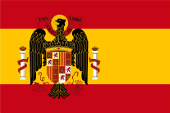 |
1945–1977, Staats- und Marineflagge – state and naval flag, Seitenverhältnis – ratio = 2:3, Quelle/Source, nach/by: Flaggen und Wappen  |
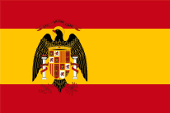 |
1977–1981, Staats- und Marineflagge – state and naval flag, Seitenverhältnis – ratio = 2:3, Quelle/Source, nach/by: Flags of the World |
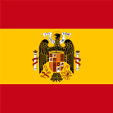 |
1945–1975, Standarte für Minister und der Kommissare in den Kolonien – standard for Ministers and the Commissioners in the colonies, Seitenverhältnis – ratio = 1:1, Quelle/Source, nach/by: Die Welt im bunten Flaggenbild |
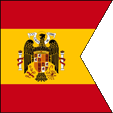 |
1945–1975, Standarte der Gouverneure in den Kolonien – standard of the Governors in the colonies, Seitenverhältnis – ratio = 1:1, Quelle/Source, nach/by: Flags of the World |
|
|
|
| Die heutige Flagge Spaniens wurde am 19.12.1981 eingeführt. Sie zeigt drei waagerechte Streifen in Rot, Gelb und Rot, im Verhältnis 1:2:1. In der Mitte des gelben Streifens das Staatswappen, zum Flaggenmast verschoben. Rot und Gelb sind seit dem Mittelalter die spanischen Nationalfarben. Sie gehen auf die Farben Kastiliens und Aragons zurück. |
The today’s flag of Spain was introduced on 19th of December in 1981. It
shows three horizontal stripes in red, yellow and red, in ratio 1:2:1. In
the middle of the yellow stripe is placed the coat of arms, moved to the
pole direction. Red and yellow are since the middle ages the Spanish national colours. They go back to the colours of Castile and León. |
| Die erste "spanische" Flagge entstand im Jahre 1230 durch die Vereinigung der Königreiche von Kastillien und Léon. | The first "Spanish" flag arised in the year 1230 by the unification of the Kingdoms of Castile and León. |
| Nachdem im Jahre 1477 mit Karl dem Kühnen der letzte Erbe des Hauses Burgund in der Schlacht von Nancy gefallen war, beanspruchte das Haus Habsburg dessen Erbe. Als die Habsburger mit Karl I. im Jahre 1516 in Spanien auf den Thon kamen wurde eine neue Flagge zur Verwendung auf See eingeführt. Sie war weiß und zeigte das rote geastete Diagonalkreuz der Burgunder. Flaggen in Rot und Gelb blieben aber weiterhin in Gebrauch und zeigten ein sehr unterschiedliches Erscheinungsbild, häufig Kreuze aber auch mehrere Streifen. Unter der Herrschaft der Habsburger wurde diese Praxis beibehalten. |
After Carl the Valiant – the last heir of the house of Burgund – fell in
1477 in the battle of Nancy, the house of Habsburg claimed his heritage. As
the house of Habsburg with Karl I. came onto the throne in Spain in 1516,
there was introduced a new flag for using at sea. It was white and showed
the red diagonal bough-cross of the house of Burgund. But flags in red and yellow remained in use moreover and showed a very different appearance, frequently crucifixes but several stripes too. Under the rule of the house of Habsburger that practice was continued. |
| Im Jahre 1700 kamen nach dem Aussterben der spanischen Habsburger die Bourbonen auf den Thron. Die spanischen Flaggen zeigten nun das Weiß der Bourbonen und darauf das Wappen Spaniens. | In the year 1700 the house of the Bourbons came on the throne after the vanish of the Spanish Habsburgs. The Spanish flags showed now the white of the Bourbons and on it the coat of arms of Spain. |
| Im Jahre 1785 wurde eine neue Flagge eingeführt. Sie sollte die spanischen Schiffe auf dem Meer besser kennzeichnen, da es in dieser Zeit viele weiße Flaggen gab. Die neue Flagge zeigte bereits das Grundmuster von heute, die drei horizontalen Streifen in Rot, Gelb und Rot, im Verhältnis 1:2:1. In der Mitte des gelben Streifens befand sich – zum Mast hin verschoben – ein verkürztes Wappen (Kartusche) mit der Heraldik von Kastilien und Leon, darüber eine Krone. | In the year 1785 was introduced a new flag. It should mark better the Spanish ships at sea, because there were many white flags at that time. The new flag showed already the basic pattern of today, the three horizontal stripes in red, yellow and red, in ratio 1:2:1. In the middle of the yellow stripe was placed – moved to the pole – an abridged coat of arms (cartouche) with the heraldry of Castile and León, above that a crown. |
| In den Jahren 1873 und 1874 war Spanien kurzzeitig eine Republik (Erste Republik). In dieser Zeit wurde die Krone über der Kartusche entfernt. | In the years 1873 and 1874 Spain was momentary a republic (First Republic). In this time the crown above the cartouche was removed. |
| Im Jahre 1931 trat der König zurück und Spanien wurde erneut Republik (Zweite Republik). Es wurde eine neue Flagge eingeführt. Sie zeigte drei gleich breite Streifen in Rot, Gelb und Morado (Maulbeerfarbe). Morado ist die Farbe des Löwen im Wappen von León. Das neue Wappen der Republik wurde in der Staatsflagge die Mitte des gelben Streifens gesetzt. Es trug eine Mauerkrone, das Symbol bürgerlicher Souveränität. | In the year 1931 the king resigned and Spain became a republic again (Second Republic). It was introduced a new flag. It showed three identical wide stripes in red, yellow and morado (mulberry colour). Morado is the colour of the lion in the coat of arms of León. The new coat of arms of the republic was placed into the middle of the yellow stripe. |
| Im Juli des Jahres 1936 erhoben sich unter General Franco die spanischen Truppen in Nordafrika gegen die Zentralregierung, die nach einer Wahl aus Kommunisten, Sozialisten, Anarchisten und Republikanern gebildet wurde. Es begann der Spanische Bürgerkrieg. Die aufständischen Truppen verwendeten ab 1936 eine Flagge mit drei gleich breiten Streifen in Rot, Gelb und Rot und dem Wappen der Republik in der Mitte des gelben Streifens. Jedoch befand sich über dem Wappen eine Mauerkrone, das Symbol bürgerlicher Souveränität. | In July 1936 rebeled the Spanish troops in North Africa under General Franco against the central government, which was formed after election by communists, socialists, anarchists and republicans. This was the beginning of the Spanish Civil War. The rebellious troops used since 1936 a flag with three identical wide stripes in red, yellow and red and with the coat of arms of the republic in the middle of the yellow stripe. But there was placed a mural crown above the coat of arms, the symbol of civic sovereignty. It was crowned by a mural crown, the symbol of bourgeois sovereignty. |
| Die rot-gelb-rote Flagge der aufständischen Truppen entstand im Spätsommer 1936 während des Krieges. Vorher wurde noch die rot-gelb-morado-farbene Flagge verwendet. Die neue Flagge entstand, indem man zwei republikanische Flaggen zerteilte. An der einen den morado-farbenen Streifen entfernte, und an der anderen einen roten. Der abgetrennte rote Streifen wurde dann anstelle des morado-farbenen Streifens angenäht. |
The red-yellow-red flag of the rebel troops emerged in the late summer of
1936 during the war. Previously, the red-yellow-morado colored flag was
still being used. The new flag was created by two cuted up republican flags. On the one was removed the morado-colored stripe and on the other a red stripe. The separated red stripe was then sutured in place of the morado-colored stripe. |
| Als General Franco im Jahre 1939 die Macht ergriff, führte er eine neue Flagge ein. Sie zeigte die Gestaltung von vor 1931, drei waagerechte Streifen in Rot, Gelb und Rot, im Verhältnis 1:2:1, jedoch zeigte sie in der Mitte des gelben Streifens – zum Mast hin verschoben – ein neues Wappen. Dieses zeigte einen schwarzen Johannes-Adler, der das neue spanische Wappenschild auf der Brust trug, sowie das Joch und Pfeilbündel, die Abzeichen der spanischen Falange. Im Jahre 1945 wurde das Wappen in der Flagge wesentlich vergrößert, so das es nun oben und unten in die roten Streifen hineinragte. |
When General Franco seizured the power in 1939 he introduced a new flag. It
showed the designing of pre 1931, three horizontal stripes in red, yellow
and red, in ratio 1:2:1, but it showed also – moved to the pole – a new coat
of arms in the middle of the yellow stripe. That showed a black eagle of St. John which carryed the new Spanish blazon on the chest as well as the yoke and the arrow bundle, the insignia of the Spanish Falange-Party. In 1945 the coat of arms in the flag became enlarged substantially, and it reaches now above and below into the red stripes. |
| Im Jahre 1977 – zwei Jahre nach dem Tod von General Franco – wurde die Silhouette des Adlers im bestehenden Wappen für das erneuerte Königreich Spanien ein wenig abgeändert. | In the year 1977 – two years after the death of General Franco – the silhouette of the eagle in the existing coat of arms was changed a little bit for the renewed kingdom of Spain. |
| Am 19.12.1981 wurde durch erneute Änderung des Wappens die heutige Flagge eingeführt. Das neue Wappen – wieder zum Mast hin verschoben – entspricht im Prinzip dem Wappen der Zweiten Republik, jedoch wurde die Krone der Bourbonen über das Wappenschild gesetzt. | On 19th of December in 1981 was introduced the today's flag by an once more changing of the coat of arms. The new coat of arms – moved to the pole again – corresponds in principle the coat of arms of the Second Republic, but the crown of the Bourbons was placed above the blazon. |
| Die Handelsflagge Spaniens zeigte seit 1927 kein Wappen. In den Jahre davor wurde als Handelsflagge eine Sonderforn verwendet. Sie zeigte ein einfarbiges gelbes Tuch mit zwei schmalen roten Streifen in der Nähe des oberen, bzw. unteren Randes der Flagge. | The merchant flag of Spain showed ab 1927 ohne Wappen gezeigt. In the years before was used a special pattern as merchant flag. It showed a single-coloured yellow buntig with two slender red stripes near the upper respectively lower border of the flag. |
| Die Standarte des Königs ist dunkelblau mit dem königlichen Wappen in der Mitte. Dieses Wappen zeigt neben dem spanischen Wappenschild mit der Krone Joch und Pfeilbündel sowie das rote, geastete, diagonale Kreuz von Burgund und die Halskette des Ordens vom Goldenen Vlies. | The standard of the king is dark blue with the royal coat of arms in the middle. This coat of arms shows in addition to the Spanish blazon with the crown yoke and arrow bundle as well as the red diagonal bough-cross of Burgund and the collar of the Order of the Golden Fleece. |
| Alle autonomen Regionen und Gebiete in Spanien haben eigene Wappen und Flaggen. Sie gehen sehr oft auf die traditionelle Heraldik dieser Regionen zurück. | All autonomous regions and territories in Spain have got own coats of arms and flags. Very often they have their roots in the traditional heraldry of this regions. |
| Die wichtigsten Gesetze und Vorschriften, die das Aussehen der Flagge regeln sind: 1.) Spanische Verfassung von 1978, die in Artikel 4.1. festlegt: Die spanische Flagge besteht aus drei horizontalen Streifen: rot, gelb und rot, wobei die Höhe des gelben Streifens der addierten Höhe der beiden roten Streifen entspricht. 2.) Königliches Dekret 441 von 1981, das die detaillierten technischen Spezifikationen der Flaggenfarben Rot und Gelb festlegt, und zwar als CIELAB-Werte, aus denen sich hexadezimal folgendes ableiten lässt: Rot = #AD1519 und Gelb = #FABD00. Diese Farbwerte ergeben, wenn man sie für den Druck umsetzt ein sehr braunes Rot und ein tiefes Goldgelb. In der Praxis werden diese sehr dunklen und gewöhnungsbedürftigen Farben kaum verwendet, noch nicht mal in Spanien selbt. Im Handel findet man häufig ein kräftiges Rot und Goldgelb, aber leider auch helles Rot und Schwefelgelb. Das in den Flaggen der Republik verwendete Murado ist nicht definiert. |
The main laws and
regulations governing the appearance of the flag are: 1st) Spanish
Constitution of 1978, which states in article 4.1: The Spanish flag shall
consist of three horizontal stripes: red, yellow and red, the height of the
yellow stripe being equal to the added height of the two red stripes. 2nd)
Royal Decree 441 of 1981, which establishes the detailed technical
specifications of the flag colours red and yellow, as CIELAB values from
which the following values can be derived in hexadecimal: Red = #AD1519 and
Yellow = #FABD00. These colour values, when converted for printing, result in a very brown red and a deep golden yellow. In practice, these very dark colours that take some getting used to are hardly ever used, not even in Spain itself. In the trade, one often finds a strong red and golden yellow, but unfortunately also light red and sulphur yellow. The Murado colour – used in the flags of the Republic – is not defined. |
  |
|
| Quelle/Source: Die Welt der Flaggen, Flaggen und Wappen der Welt, Wikipedia (EN), Flags of the World, Flaggen Wappen Hymnen, Volker Preuß, Jürgen Kaltschmitt | |
Wappen – Coat of Arms: |
|
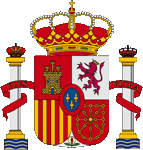 |
Wappen des Königreichs Spanien – coat of arms of the Kingdom of Spain, Quelle/Source: Corel Draw 4 |
historische Wappen – historical Coats of Arms: |
|
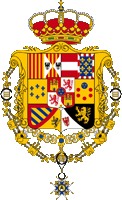 |
1761–1931, Wappen des Königreichs Spanien – coat of arms of the Kingdom of Spain, Quelle/Source, nach/by: Heralder, CC BY-SA 3.0, via Wikimedia Commons |
 |
1931–1939, Wappen von Spanien – coat of arms of Spain, Quelle/Source, nach/by: Heralder, CC BY-SA 3.0, via Wikimedia Commons |
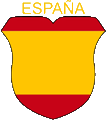 |
1941–1945, Ärmelabzeichen – Sleeve badge, Blaue Division / Spanische Legion – División Azul / Legión Española, Quelle/Source, nach/by: Wikipedia (ES) |
 |
1945–1977, Wappen von Spanien – coat of arms of Spain, Quelle/Source, nach/by: Heralder, CC BY-SA 3.0, via Wikimedia Commons |
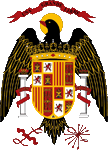 |
1977–1981, Wappen des Königreichs Spanien – coat of arms of the Kingdom of Spain, Quelle/Source, nach/by: Flags of the World |
| Das heutige Staatswappen Spaniens wurde am 19.12.1981 eingeführt und zeigt einen viergeteilten Schild mit einer silbernen Spitze. In den Feldern des Schildes die Heraldik der historischen Regionen, aus denen Spanien entstanden ist: Burg (Kastilien), Löwe (León), vier rote Pfäle auf Gelb (Aragon), und goldene Ketten auf Rot (Navarra). In der silbernen Spitze der Granatapfel von Granada. In der Mitte des Schildes befindet sich eine blaue, rotgeränderte Kartusche mit drei Lilien, das Abzeichen der herrschenden Dynastie, dem Haus Bourbon. Über dem Wappenschild die königliche Krone. Links und rechts neben dem Wappenschild die "Säulen des Herkules" (eigentlich die beiden Felsspitzen zu beiden Seiten der Meerenge von Gibraltar) als Symbol des überseeischen Einflusses von Spanien. Auf den Säulen das Staatsmotto: "Plus ultra" → "immer weiter". Es erinnert an die große seefahrerische und koloniale Vergangenheit des Landes. | The
today’s coat of arms of Spain was introduced on 19th of December in 1981 and
shows a fourfold divided shield with a silvery point. In the fields of the
shield the heraldry of the historic regions, out of them Spain was formed:
castle (Castile), lion (León), four red poles on yellow (Aragon), and golden
chains on red (Navarra). In the silvery point the pomegranate of Granada. In
the middle of the shield is placed a blue red-bordered cartouche with three
lilies, the insignia of the ruling dynasty, the house of Bourbon. Above the
blazon the royal crown. To the left and on the right beside the blazon the "columns of Hercules" (actually the both rocks on both sides of the Strait of Gibraltar) as symbol for the transoceanic influence of Spain. On the columns the motto of the state: "Plus ultra" → "always further". It remembers the great nautical and colonial history of the country. |
| Als im Jahre 1580 das portugiesische Königshaus von Aviz ausstirbt, wird Portugal in Personalunion mit Spanien verbunden. Der König von Spanien regiert nun beide Länder, aber auch deren koloniale Besitzungen in der ganzen Welt, das spanische Westindien (Kuba, Hispaniola, Puerto Rico, usw.) und auch das portugiesische Ostindien (Goa, Diu, Damao, Kotschin, Kalikat und Teile von Ceylon). Darauf hin nahm der König den bis ins 19. Jahrhundert (als Anspruchs-Titel) beibehaltenen Titel "Herr beider Indien" an, wofür die beiden Säulen ebenfalls stehen. 1640 trennt sich Portugal wieder von Spanien und muss Ceuta an Spanien abtreten. (1) | When in
1580 the Portuguese Royal House of Aviz extincts, becomes Portugal connected
with Spain in personal union. The King of Spain rules now over both countries, but also over their colonial possessions in the world, the Spanish West Indies (Cuba, Hispaniola, Puerto Rico, etc.) and also Portuguese East India (Goa, Diu, Damao, Cochin, Kalikat and parts of Ceylon). Whereupon the king took over, the to the 19th century retained (as claim title) title "Lord of the two Indies", for what the two columns also stand. In 1640 Portugal separates again from Spain and has to cede Ceuta to Spain.(1) |
| Bis 1931 bestand das Wappen aus einem ovalen Schild, dass außer der Heraldik von Kasilien, León, Aragon und der Bourbonen die Heraldik der ehemaligen Spanisch-Habsburgischen Nebenländer zeigte. So zum Beispiel von Sizilien, Burgund, Parma, Toskana, Brabant, Flandern und Tirol. | Until
1931 the coat of arms existed in an oval shield, which showed besides the
heraldry of Casile, León, Aragon and of the Bourbons the heraldry of the
former Spanish-Habsburg dependenceies. For example of Sicily, Burgund, Parma, Tuscany, Brabant, Flanders and Tyrolia. |
| Mit der Zweiten Republik wurde ein neues Wappen eingeführt, das im wesentlichen dem heutigen Wappen glich. Es trug jedoch eine Mauerkrone, das Symbol bürgerlicher Souveränität. Das war im "Decreto de Gobernio Provisional de la Republica de 27 de abril de 1931" festgelegt worden. Darin heißt es ausdrücklich: "Al timbre corona mural ..." | With the Second Republic was introduced a new coat of arms, which essentially resembled the today's coat of arms. But, it was crowned by a mural crown, the symbol of bourgeois sovereignty. This was laid down in the "Decreto de Gobernio Provisional de la Republica de 27 de abril de 1931". It states explicitly: "Al timbre Corona mural ..." |
| Im Jahre 1938 führte General Franco ein neues Wappen ein. Es zeigte einen großen schwarzen Adler (Johannisadler) und die Abzeichen der spanischen Falange-Partei, das Joch und das Pfeilbündel. Auf der Brust des Adlers ein Wappenschild, der vielfach unterteilt die Heraldik von Kastilien, León, Aragon, Navarra und Granada zeigte. Oberhalb des Adlers befand sich ein rotes Spruchband mit dem Motto der Spanischen Falange-Partei: "una, grande, libre" → "einig, groß, frei". Im Jahre 1977 – zwei Jahre nach dem Tod von General Franco – wurde das Wappen (z.B. in der Form des Adlers) geringfügig abgeändert, und schließlich am 19.12.1981 das heutige Wappen eingeführt. | In the year 1938 General Franco introduced a new coat of arms. This showed a big black eagle (Eagle of St. John) and the insignia of the Spanish Falange Party, the yoke and the arrow bundle. On the chest of the eagle a blazon which showed multiply subdivided the heraldry of Castile, León, Aragon, Navarra and Granada. Above the eagle was placed a red banner with the motto of the Spanish Falange: "una, grande, libre" → "united, great, free". In the year 1977 – two years after the death of General Franco – the coat of arms was changed a little bit (e.g. in the form of the eagle)and finally was introduced on 19th of December in 1981 the today’s coat of arms. |
| Das heutige Wappen ist ein Kompromiss zwischen jenen Spaniern die das Wappen des Generals Franco weitestgehend beibehalten wollten, und jenen Spaniern, die das Wappen der Ersten Republik wieder einführen wollten. | The today’s coat of arms is a compromise between those Spaniards which wanted to continue the coat of arms of General Franco and those Spaniards which wanted to introduce the coat of arms of the First Republic again. |
| Quelle/Source: (1) Jürgen Kaltschmitt, Die Welt der Flaggen, Flaggen und Wappen der Welt, Wikipedia (EN), Flags of the World, Flaggen Wappen Hymnen, Volker Preuß | |
Flugzeugkokarde – aircraft roundel: |
|
 |
Flugzeugkokarde – aircraft roundel Quelle/Source, nach/by: Wikipedia (EN) |
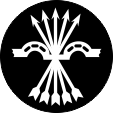 |
1936–1939, Flugzeugkokarde des Spanischen Staates – aircraft roundel of the Spanish State Quelle/Source, nach/by: Wikipedia (EN) |
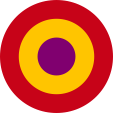 |
1936–1939, Flugzeugkokarde der Spanischen Republik – aircraft roundel of the Spanish Republic Quelle/Source, nach/by: Wikipedia (EN) |
|
|
|
Landkarten – Maps: |
Lage – Position: |
Landkarte des Landes – Map of the Country: |
|
Karte der historischen Königreiche auf der
Iberischen Halbinsel – Map of the historical Kingdoms on the Iberian Peninsula |
| ca. 1220 |
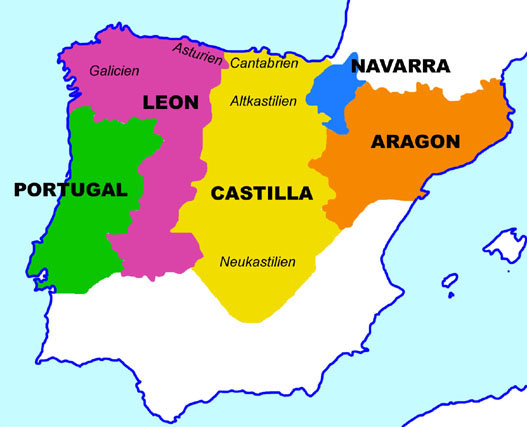 |
| Landkarte/Map: Volker Preuß |
|
Die autonomen Regionen Spaniens – The autonomous Regions of Spain: (Interaktive Landkarte - interactive map) |
|||
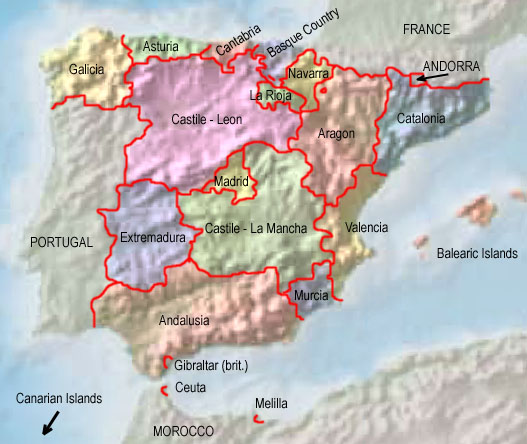 |
|||
| Quelle/Source: Freeware, University of Texas Libraries, modyfied by: Volker Preuß | |||
|
|
|||
| Liste der autonomen Regionen Spaniens – List of the autonomous Regions of Spain: | |||
|
|
|||
| Andalusien Aragonien Asturien Balearen Baskenland Extremadura Galicien Kantabrien |
Andalusia Aragón Asturia Balearic Islands Basque Country Extremadura Galicia Cantabria |
||
|
Überseegebiet: Kanaren (← hier klicken) |
Overseas
Territory: Canary Islands (← click here) |
|
Spanisch-Marokko |
Possessions:
Spanish Morocco |
| Zahlen und Fakten – Numbers and Facts: | |
|
|
|
|
|
|
|
|
|
|
|
|
|
|
|
|
|
|
|
Frühzeit
· Besiedlung durch Iberische Stämme und Basken ca. 1100 v.Chr. · die Phönizier gründen Kolonien an der Küste des Mittelmeeres (Malaca, Abdera, Lucentum ...) ca. 800 v.Chr. · die Griechen gründen Kolonien an der Küste des Mittelmeeres (Hemeroskopeion, Zakantha, Tarrakon ...) ca. 600 v.Chr. · Einwanderung von Kelten, Vermischung mit den Iberern, Herausbildung der Keltiberer 3. Jahrhundert v.Chr. · das Reich Karthago unterwirft die Süd- und Ostküste des Mittelmeeres 218–201 v. Chr. · Zweiter Punischer Krieg, das Römische Reich erwirbt die Besitzungen Karthagos in Iberien, Unterwerfung ganz Iberiens bis zum Jahre 19 v.Chr., römische Besiedlung, Romanisierung, Bildung von drei Provinzen: Hispania Tarraconensis, Lusitania und Baetica 395 n.Chr. · bei der Teilung des Römischen Reiches kommt Iberien an das Weströmische Reich ca. 400 · Völkerwanderung, Einwanderung von Alanen, Sweben und Wandalen ca. 413 · Völkerwanderung, Einwanderung der Westgoten, sie Sueben halten sich bis 585 im heutigen Portugal und Galicien, die Wandalen weichen nach Nordafrika aus ca. 440–450 · der Westgotenkönig Eurich vertreibt die Römer ca. 460–480 · der Westgotenkönig Leowigild erobert ganz Iberien 554 · das Oströmische Reich (Byzanz) erobert die Provinz Baetica im Süden der Iberischen Halbinsel 711–714 · von Nordafrika kommende Araber erobern das Westgotenreich außer einem schmalen Küstenstreifen im Norden, bestehend aus Teilen des heutigen Galicien (hier klicken), Asturien (hier klicken), Navarra, und Ober-Aragonien 732 · der Vormarsch der Araber wird bei Poitiers im Frankischen Reich gestoppt 756–1031 · arabisches Emirat von Cordoba unter der Dynastie der Omajjaden, die Araber bilden nur die Oberschicht und müssen sich mit den ursprünglichen Einwohnern arrangieren, dadurch unterbleibt die sonst übliche Vernichtung und Ausrottung der ursprünglichen Kulturen im arabischen Eroberungsraum, das Kalifat erlangt eine kulturelle und wirtschaftliche Blütezeit 925 · Herausbildung der Königreiche León und Navarra im Norden der Iberischen Halbinsel 1035 · Herausbildung der Königreiche Aragon und Kastilien im Norden der Iberischen Halbinsel 1035–1262 · schrittweise Befreiung der Iberischen Halbinsel von den Moslems durch die vier Iberischen Königreiche (Reconquista), die dehnen sich dabei territorial von Norden nach Süden aus, den Moslems verbleibt im Süden das um 1230 gegründete Emirat Granada (bis 1492) 1134 · das Königreich Navarra kommt an das Königreich Aragon 1139 · das Königreich Portugal trennt sich vom Königreich León ab 1230 · die Königreiche Kastilien und León werden zum Königreich Kastilien-León vereinigt 1469 · Isabella I., Königin von Kastilien und León heiratet Ferdinand II. von Aragón 1479 · Krönung von Ferdinand II. und Isabella I. zu Königen von Spanien 1492 · Befreiung des Emirates von Granada von den Arabern durch Spanien, Christof Kolumbus – ein genuesischer Seefahrer in spanischen Diensten – entdeckt Amerika 1494 · auf Grund von Streitigkeiten mit Portugal Abschluss des Vertrages von Tordesillas über die Aufteilung der Welt entlang des Meridians 50° w.L. 1496 · Johanna von Kastilien heiratet den Habsburger Philipp 1496–1510 · Spanien erobert die nordafrikanischen Städte Penon de Velez, Melilla, Oran und Algier 1516 · der Habsburger Karl I., Sohn von Philipp, wird König von Spanien 1519–1533 · Eroberung von Mexiko und Peru durch Hernan Cortéz und Francisco Pizarro 1521 · Eroberung/Erwerb der Philippinen durch Ferdinand Magellan (Fernão de Magalhães), einem portugiesischen Seefahrer in spanischen Diensten 28.05.1519 · Karl I. wird als Karl V. zum römisch-deutschen Kaiser gewählt 1529 · auf Grund von Streitigkeiten mit Portugal Abschluss des Vertrages von Zaragoza über die Aufteilung der Welt zwischen dem Meridian 50° w.L. und dem Meridian 145° ö.L. 1556 · Tod von Kaiser Karl V., Nachfolger wird sein Sohn Philipp II. 1580 · das portugiesische Königshaus von Aviz stirbt aus, Portugal wird in Personalunion mit Spanien verbunden 1588 · Untergang der spanischen Armada die England erobern sollte, militärischer Niedergang Spaniens, Verlust der Seeherrschaft an England und die Niederlande 1640 · Portugal trennt sich von Spanien 1700 · mit Karl II. stibt die span. Linie der Habsburger aus, Nachfolger wird der Bourbone Philipp V. 1701–1714 · Spanischer Erbfolgekrieg, die Bourbonen behalten die spanische Krone 1808 · Kaiser Napoléon I. von Frankreich besetzt Spanien und lässt nach dem Verzicht der Bourbonen seinen Bruder Joseph Bonaparte zum spanischen König proklamieren 1808–1814 · Befreiungskrieg der Spanier gegen König Joseph Bonaparte 1811–1830 · Unabhängigkeitskrieg der spanischen Kolonien in Amerika, Spanien verliert fast seinen gesamten Kolonialbesitz 1813 · Sturz von Joseph Bonaparte, Proklamation des Bourbonen Ferdinand VII. zum spanischen König, erste liberale Verfassung 1833 · Tod von König Ferdinand VII., Nachfolger wird seine Tochter Isabella II. von Bourbon 1868 · Königin Isabella II. tritt nach Unruhen zurück 1870 · Königin Isabella II. flieht nach Frankreich, Nachfolger wird König Amadeus I. von Savoyen 11.02.1873 · König Amadeus I. tritt nach einem Bürgerkrieg zurück und legt die Krone nieder, Spanien wird Republik 1874 · König Alfons XII. von Bourbon ergreift die Macht 1886 · Tod von König Alfons XII., Nachfolger wird sein Sohn Alfons XIII. 1898 · spanisch-US-amerikanischer Krieg, Frieden von Paris: Spanien muss sein Kolonialreich zum größten Teil an die USA abtreten (Philippinen, Puerto Rico und Kuba) 1814–1818 · Erster Weltkrieg, Spanien bleibt neutral 1923 · General M. Primo de Rivera errichtet ein diktatorisches Regime 1928–1929 · Aufstände 1930 · General M. Primo de Rivera tritt zurück 1931 · Kommunalwahlen, König Alfons XIII. von Bourbon tritt zurück, Spanien wird Republik 1936 · Parlamentswahlen Sieg der Volksfront (Republikaner, Sozialisten, Anarchisten, Kommunisten) 17.07.1936 · die spanischen Truppen in Spanisch-Marokko revoltieren unter der Führung der Generale Goded, Mola, de Llano und Francisco Franco gegen die drohende bolschewistische Gefahr 1936–1939 · Spanischer Bürgerkrieg unter Beteiligung vieler ausländischer Freiwilliger, auf Seiten der Volksfront: 7.500 Franzosen, 5.000 Deutsche, 4.000 Italiener, 3.000 Polen, 2.800 US-Amerikaner, 2.000 Briten 2.000 Sowjetbürger, 1.600 Belgier, 1.600 Jugoslawen, 1.500 Ungarn, 1.500 Tschechen und Slowaken, 1.500 Kanadier, 1.400 Österreicher, 800 Schweizer, 700 Niederländer, 500 Schweden, 400 Bulgaren, 250 Iren, 200 Esten, 160 Griechen, 90 Mexikaner, 60 Zyprer; auf der nationalspanischen Seite: 10.000 Portugiesen, 10.000 deutsche Soldaten der Legion Condor, 1.300 Franzosen und Wallonen, 700 Iren, ca. 200 Briten (auch aus Kanada, Südafrika und Australien), ca. 300 Exil-Russen, 200 Argentinier, 50 Peruaner, 25 Kubaner sowie Rumänen, Polen, US-Amerikaner, Phlippinos, Brasilianer, 200 christliche Schwarze aus Spanisch-Guinea und ca 70.000 mohammedanische Araber und Berber aus Spanisch-Marokko 28.03.1939 · General Franco marschiert in Madrid ein und errichtet ein diktatorisches Regime, getragen von der neuen Falange Einheitspartei, in der jetzt alle politischen Kräfte der nationalspanischen Bürgerkriegsparteien - teilweise unter Druck und Zwang - vereinigt worden waren, und der katholischen Kirche 1939–1945 · Zweiter Weltkrieg, Spanien bleibt neutral, 17.500 Spanier kämpfen freiwillig in der "Blauen Division" an der Seite des Deutschen Reiches gegen die Sowjetunion März 1947 · General Franco erklärt Spanien zur katholischen Monarchie, im Falle seines Rücktritts oder seines Todes soll die Monarchie in vollem Umfang wieder hergestellt werden 1955 · Spanien wird Mitglied der UNO 02.03.1956 · Unabhängigkeit für Marokko, Spanien muss Spanisch-Marokko (jedoch nur Rif-Gebiet) an Marokko zurückgegeben 1958 · Spanien gibt den Oueddra-Streifen an Marokko zurück 29.07.1968 · Spanien entlässt Spanisch-Guinea in die Unabhängigkeit 1969 · Spanien gibt die Enklave Ifni an Marokko zurück 1969 · Prinz Juan Carlos de Borbón y Borbón, ein Enkel von König Alfons' XIII., wird zum Thronfolger bestimmt 1975 · Spanien verzichtet auf seine Rechte in Westsahara, das Selbstbestimmungsrecht von Westsahara wird international anerkannt, Marokko und Mauretanien marschieren in Westsahara ein 20.11.1975 · Tod von General Francisco Franco 27.11.1975 · König Juan Carlos I. besteigt den Thron 1978 · neue Verfassung, Spanien wird parlamentarische konstitutionelle Monarchie 1982 · Spanien wird Mitglied der NATO 01.01.1986 · Spanien wird Mitglied der EG (heute: EU, Europäische Union) 19.06.2014 · Felipe VI. (Philipp VI.), Sohn von Juan Carlos I., besteigt nach dem Rücktritt seines Vaters den Thron |
|
early age
· settlement by Iberian tribes and Basques ca. 1100 B.C. · Phoenicians establish colonies at the coast of the Mediterranean Sea (Malaca, Abdera, Lucentum ...) ca. 800 B.C. · Greeks establish colonies at the coast of the Mediterranean Sea (Hemeroskopeion, Zakantha, Tarrakon ...) ca. 600 B.C. · immigration of Celts, mix with the Iberians, evolution of the Celtiberians 3rd century B.C. · the Empire of Carthago submits the southern and eastern coast of the Mediterranean Sea 218–201 B.C. · Second Punic War, the Roman Empire acquires the possessions of Carthago in Iberia, subjugation of whole Iberia until the year 19 B.C., Roman settlement, romanization, formation of three provinces: Hispania Tarraconensis, Lusitania and Baetica 395 A.D. · at the partition of the Roman Empire Iberia comes to the West Roman Empire (Rome) ca. 400 · Migration Period (Barbarian Invasions), immigration of Alans, Suebs and Vandals ca. 413 · Migration Period, immigration of the Western Goth, the Suebs withstand until 585 in the today’s Portugal and Galicia, the Vandals dodge to Northern Africa ca. 440–450 · Eurich the King of the Western Goth banishes the Romans ca. 460–480 · Leowigild the King of the Western Goth conquers whole Iberia 554 · The East Roman Empire (Byzantium) conquers the province of Baetica in the south of the Iberian peninsula 711–714 · from northern Africa coming Arabs conquer the Empire of the Western Goth except a slender coastal stripe in the north (Asturia, Navarra, Aragon) 732 · the advance of the Arabs becomes stopped near Poitiers in the Frankish Empire 756–1031 · Arabian Emirate of Cordoba under the dynasty of the Omajjads, the Arabs were only the upper class and had to arrange with the original inhabitants, because of that omits the in the Arabian conquest-area otherwhere usual annihilation and eradication of the original civilizations, the califate achieves a cultural and economical flowering period 925 · establishment of the kingdoms of León and Navarra in the north of the Iberian peninsula 1035 · establishment of the kingdoms of Aragon and Castile in the north of the Iberian peninsula 1035–1262 · step by step liberation of the Iberian peninsula from the muslims by the four Iberian kingdoms (Reconquista), they expand territorially in this way from north to south, the muslims remain in the south in the ca. 1230 established Emirate of Granada (until 1492) 1134 · the kingdom of Navarra comes to the kingdom of Aragon 1139 · the kingdom of Portugal separates from the kingdom of León 1230 · the kingdoms of Castile and León become united to the kingdom of Castile-León 1469 · Isabella I., queen of Castile and León marrys Ferdinand II. of Aragón 1479 · Ferdinand II. and Isabella I. become crowned to the Kings of Spain 1492 · liberation of the Emirate of Granada from the Arabs by Spain, Christof Columbus – a Genuese seafarer in Spanish serve – discoveres America 1494 · because of quarrels with Portugal pass of the Treaty of Tordesillas about the division of the world along the meridian 50° w.L. 1496 · Johanna of Castile marrys Philipp from the house of Habsburg 1496–1510 · Spain conquers the north african places Penon de Velez, Melilla, Oran and Algier 1516 · Karl I. from the house of Habsburg, son of Philipp, becomes King of Spain 1519–1533 · conquest of Mexiko and Peru by Hernan Cortéz and Francisco Pizarro 1521 · conquest/acquisition of the Philippine Islands by Ferdinand Magellan (Fernão de Magalhães), a Portugese seafarer in Spanish serve 28th of May 1519 · Karl I. becomes elected as Karl V. to the Roman-German emperor 1529 · because of quarrels with Portugal pass of the Treaty of Zaragoza about the division of the world along the meridian 50° w.L. and the meridian 145° e.L. 1556 · death of emperor Karl V., successor is his son Philipp II. 1580 · the house of the kings of Aviz vanishes, Portugal becomes united with Spain in personal union 1588 · sinking of the Spanish Armada which should conquer England, military decline of Spain, loss of the naval supremacy to England and the Netherlands 1640 · Portugal separates from Spain 1700 · with Karl II. vanishes the Spanish line of the Habsburgs, successor is Philipp V. from the house of Bourbon 1701–1714 · Spanish Successor War, the Bourbons hold the Spanish crown 1808 · Emperor Napoléon I. of France occupies Spain and keeps proclaim his brother Joseph Bonaparte to the Spanish king after the resign of the Bourbons 1808–1814 · liberation war of the Spanish against King Joseph Bonaparte 1811–1830 · independence-war of the Spanish colonies in America, Spain loses nearly its whole colonial possession 1813 · overthrow of Joseph Bonaparte, proclamation of the Bourbone Ferdinand VII. to the Spanish king, first liberal constitution 1833 · death of King Ferdinand VII., successor is his daughter Isabella II. of Bourbon 1868 · Queen Isabella II. resigns after revolts 1870 · Queen Isabella II. escapes to France, successor is King Amadeus I. of Savoy 11th of February 1873 · King Amadeus I. resigns after a civil war and lays down the crown, Spain becomes a republic 1874 · King Alfons XII. of Bourbon seizes the power 1886 · death of King Alfons XII., successor is his son Alfons XIII. 1898 · Spanish-US-American war, Peace of Paris: Spain has to cede the bigest part of its colonial possessions to the USA (Philippines, Puerto Rico and Cuba) 1814–1818 · First World War, Spain is neutral 1923 · General M. Primo de Rivera establishes a dictatorial regime 1928–1929 · revolts 1930 · General M. Primo de Rivera resigns 1931 · communal elections, König Alfons XIII. of Bourbon resigns, Spain becomes a republic 1936 · parliamentary elections, victory of the Popular Front (republicans, socialists, anarchists, communiss) 17th of July 1936 · the Spanish troops in Spanish Morocco revolt under the leadership of the Generals Goded, Mola, de Llano and Francisco Franco against the threatening bolshevist danger 1936–1939 · Spanish Civil War under participation of many foreign volunteers on the part of the Popular Front: 7.500 French, 5.000 Germans, 4.000 Italians, 3.000 Poles, 2.800 US-Americans, 2.000 British 2.000 Soviets, 1.600 Belgians, 1.600 Yugoslavs, 1.500 Hungarians, 1.500 Czechs and Slovaks, 1.500 Canadians, 1.400 Austrians, 800 Swiss, 700 Dutch, 500 Swedes, 400 Bulgarians, 250 Irish, 200 Estonians, 160 Greeks, 90 Mexicans, 60 Cypriots; on the national Spanish side: 10.000 Portuguese, 10.000 German soldiers of the Condor Legion, 1.300 French and Walloons, 700 Irish, 200 British (also from Canada, South Africa and Australia), about 300 exiled Russians, 200 Argentines, 50 Peruvians, 25 Cubans and Romanians, Poles, US-Americans, Phlippinos, Brazilians, 200 Christian blacks from Spanish Guinea and about 70.000 Muslim Arabs and Berbers from Spanish Morocco 28th of March 1939 · General Franco marches in to Madrid and establishes a dictatorial regime, supported by the new Falange unity party, in which all the political forces of the National-Spanish Civil War parties had been united - partly under pressure and coercion - and by the Catholic Church 1939–1945 · Second World War, Spain is neutral, 17.500 Spaniards fight voluntary in the "Blue Division" on the side of the German Empire against the Soviet Union March 1947 · General Franco declares Spain to a catholic monarchy, in the case of his withdrawal or of his death the monarchy should become re-established in full size 1955 · Spain becomes a member of the UNO 2nd of March 1956 · independence for Morocco, Spain has to cede Spanish Morocco (but only the Rif Area) to Morocco 1958 · Spain cedes the Oueddra Stripe to Morocco 29th of July 1968 · Spain grants Spanish Guinea the independence 1969 · Spain cedes the enclave of Ifni to Morocco 1969 · Prince Juan Carlos de Borbón y Borbón – a grandson of King Alfons' XIII. - becomes destined to the throne successor 1975 · Spain disclaims its rights in Western Sahara, the right of self-determination of Western Sahara becomes Internationally recognized, Morocco and Mauritania invade in Western Sahara 20th of November 1975 · death of General Francisco Franco 27th of November 1975 · King Juan Carlos I. is enthroned 1978 · new constitution, Spain becomes a parliamentary constitutional monarchy 1982 · Spain becomes a member of the NATO 1st of January 1986 · Spain becomes a member of the EC (today: EU, European Union) 19th of June in 2014 · Felipe VI. (Philip VI.), son of Juan Carlos I. ascends to the throne, after the resignation of his father |
| Quelle/Source: Wikipedia (D), World Statesmen, Volker Preuß, Jürgen Kaltschmitt |
| Der Name
"Spanien" geht wahrscheinlich auf das seefahrende Volk der Phönizier zurück.
Diese nannten es "I-Shepanim", was "Küste der Murmeltiere" heißt. Der Name
wurde beibehalten, denn auch die Römer nannten ihre Provinzen "Hispania
ulterior", oder "Hispania citerior", oder "Hispania Tarraconensis". Das Volk der Spanier gibt es aus diesem Grunde nicht. Es gibt nur die Stämme der Nachfahren der Keltiberer und die Basken, die seit 1469 in einer Art gemeinsamen spanischen Staat leben. |
The name "Spain" has its roots probably in the seafaring people of the Phoenicians zurück. They named it "I-Shepanim", what means "Coast of the Marmots". The name was continued because even the Romans called their provinces "Hispania ulterior", or "Hispania citerior", or "Hispania Tarraconensis". The nation of the Spanish is thats because not existend. There are only tribes of the successors of the Celtiberians and the Basques, which live since 1469 together in a kind of a common Spanish state. |
| Quelle/Source: Handbuch der geographischen Namen, Atlas zur Geschichte, Volker Preuß | |